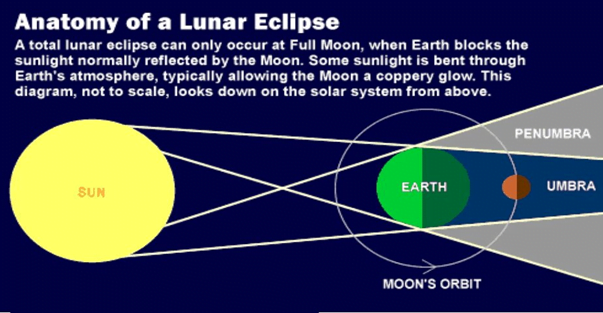Geography
Context: The partial solar eclipse or Surya Grahan on October 25 marks the last solar eclipse of the year. The eclipse will be visible from parts of Europe, Northern Africa and large parts of western and central Asia. Most of India should be able to view the solar eclipse, apart from some parts in the Northeast.
About Eclipses:
- An eclipse happens when a planet or a moon gets in the way of the sun’s light.
- When the light of the Sun or the Moon is blocked by another body, the sun or Moon is said to be in eclipse.
- Here on Earth, we can experience two kinds of eclipses: solar eclipses and lunar eclipses.
Solar Eclipse:

- Also known as the eclipse of the sun, it occurs when the moon comes in between the sun and the earth. As a result, the moon blocks the light of the sun from reaching the earth’s surface and casts a shadow on it.
- This occurs on a new moon phase.
- We can observe up to 5 solar eclipses per year.
Type of Solar Eclipses:
- Eclipses may be classified into 4 types i.e., Annular, Total, Partial and Hybrid.
- The type of eclipse we experience depends on the type of shadow that is involved.
- Both the Moon and Earth cast 3 shadows: umbra, penumbra, and an antumbra.
- The umbra is a shadow’s dark core: It means If you are standing within the umbra, you will not be able to see any part of the light source as the object blocks all direct light rays.
- The penumbra is a half-shadow that occurs when a light source is only partly covered by an object
- Antumbra – the lighter part of the shadow that begins where the umbra ends.
- Total Eclipse: This occurs when the Sun is completely obscured from the rich. Instead, the Sun’s intense light is replaced by the dark silhouette of the Moon that is outlined by the Sun’s corona (the super-heated plasma extending out from the Sun.
- Annular Eclipse: Occurs when the Sun and Moon are exactly in line but Moon appears smaller than the Sun. During one annular eclipse, the Sun appears as a bright ring around the Moon.
- Partial Eclipse: Occurs when the Sun and Moon are not completely aligned and the Sun is partially obscured.
- Hybrid Eclipse: Hybrid Eclipse is a combination of total and annular eclipse that takes place when a total eclipse changes to an annular eclipse or vice-versa along different sections of the eclipse’s path.
Lunar Eclipse:

- A lunar eclipse occurs when the Moon moves into the Earth’s shadow.
- This can occur only when the Sun, Earth, and Moon are exactly or very closely aligned with Earth between the other two, which can happen only on the night of a full moon when the moon is near either lunar node.
There are 3 kinds of lunar eclipses:
- A total lunar eclipse occurs when Earth’s umbra – the central, dark part of its shadow – obscures all of the Moon’s surface.
- A partial lunar eclipse can be observed when only part of the Moon’s surface is obscured by Earth’s umbra.
- A penumbral lunar eclipse happens when the Moon travels through the faint penumbral portion of Earth’s shadow.
Source: Indian Express
Previous Year Questions
Q.1) In the northern hemisphere, the longest day of the year normally occurs in the: (2021)
- First half of the month of June
- Second half of the month of June
- First half of the month of July
- Second half of the month of July
Q.2) On 21st June, the Sun (2019)
- does not set below the horizon at the Arctic Circle
- does not set below the horizon at Antarctic Circle
- shines vertically overhead at noon on the Equator
- shines vertically overhead at the Tropic of Capricorn












